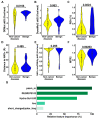Identifying the Molecular Drivers of Pathogenic Aldehyde Dehydrogenase Missense Mutations in Cancer and Non-Cancer Diseases
- PMID: 37373306
- PMCID: PMC10299257
- DOI: 10.3390/ijms241210157
Identifying the Molecular Drivers of Pathogenic Aldehyde Dehydrogenase Missense Mutations in Cancer and Non-Cancer Diseases
Abstract
Human aldehyde dehydrogenases (ALDHs) comprising 19 isoenzymes play a vital role on both endogenous and exogenous aldehyde metabolism. This NAD(P)-dependent catalytic process relies on the intact structural and functional activity of the cofactor binding, substrate interaction, and the oligomerization of ALDHs. Disruptions on the activity of ALDHs, however, could result in the accumulation of cytotoxic aldehydes, which have been linked with a wide range of diseases, including both cancers as well as neurological and developmental disorders. In our previous works, we have successfully characterised the structure-function relationships of the missense variants of other proteins. We, therefore, applied a similar analysis pipeline to identify potential molecular drivers of pathogenic ALDH missense mutations. Variants data were first carefully curated and labelled as cancer-risk, non-cancer diseases, and benign. We then leveraged various computational biophysical methods to describe the changes caused by missense mutations, informing a bias of detrimental mutations with destabilising effects. Cooperating with these insights, several machine learning approaches were further utilised to investigate the combination of features, revealing the necessity of the conservation of ALDHs. Our work aims to provide important biological perspectives on pathogenic consequences of missense mutations of ALDHs, which could be invaluable resources in the development of cancer treatment.
Keywords: aldehyde dehydrogenase; cancer; machine learning; missense mutations; pathogenic molecular driver.
Conflict of interest statement
The authors declare no conflict of interest.
Figures






Similar articles
-
Aldehyde dehydrogenases and their role in carcinogenesis.Crit Rev Biochem Mol Biol. 1992;27(4-5):283-335. doi: 10.3109/10409239209082565. Crit Rev Biochem Mol Biol. 1992. PMID: 1521460 Review.
-
Insights into Aldehyde Dehydrogenase Enzymes: A Structural Perspective.Front Mol Biosci. 2021 May 14;8:659550. doi: 10.3389/fmolb.2021.659550. eCollection 2021. Front Mol Biosci. 2021. PMID: 34055881 Free PMC article. Review.
-
Aldehyde toxicity and metabolism: the role of aldehyde dehydrogenases in detoxification, drug resistance and carcinogenesis.Drug Metab Rev. 2019 Feb;51(1):42-64. doi: 10.1080/03602532.2018.1555587. Epub 2019 Apr 22. Drug Metab Rev. 2019. PMID: 30514131 Review.
-
Aldehyde dehydrogenases as drug targets for cancer: SAR and structural biology aspects for inhibitor design.Bioorg Chem. 2025 Jan;154:108019. doi: 10.1016/j.bioorg.2024.108019. Epub 2024 Dec 4. Bioorg Chem. 2025. PMID: 39689509 Review.
-
Aldehyde dehydrogenases: from eye crystallins to metabolic disease and cancer stem cells.Chem Biol Interact. 2013 Feb 25;202(1-3):2-10. doi: 10.1016/j.cbi.2012.10.026. Epub 2012 Nov 16. Chem Biol Interact. 2013. PMID: 23159885 Free PMC article. Review.
Cited by
-
Exploring the effects of missense mutations on protein thermodynamics through structure-based approaches: findings from the CAGI6 challenges.Hum Genet. 2025 Mar;144(2-3):327-335. doi: 10.1007/s00439-023-02623-4. Epub 2024 Jan 16. Hum Genet. 2025. PMID: 38227011 Free PMC article.
-
Engineering G protein-coupled receptors for stabilization.Protein Sci. 2024 Jun;33(6):e5000. doi: 10.1002/pro.5000. Protein Sci. 2024. PMID: 38747401 Free PMC article.
References
-
- Koppaka V., Thompson D.C., Chen Y., Ellermann M., Nicolaou K.C., Juvonen R.O., Petersen D., Deitrich R.A., Hurley T.D., Vasiliou V. Aldehyde dehydrogenase inhibitors: A comprehensive review of the pharmacology, mechanism of action, substrate specificity, and clinical application. Pharmacol. Rev. 2012;64:520–539. doi: 10.1124/pr.111.005538. - DOI - PMC - PubMed
-
- Liu Z.J., Sun Y.J., Rose J., Chung Y.J., Hsiao C.D., Chang W.R., Kuo I., Perozich J., Lindahl R., Hempel J., et al. The first structure of an aldehyde dehydrogenase reveals novel interactions between NAD and the Rossmann fold. Nat. Struct. Biol. 1997;4:317–326. doi: 10.1038/nsb0497-317. - DOI - PubMed
MeSH terms
Substances
Grants and funding
LinkOut - more resources
Full Text Sources
Medical

